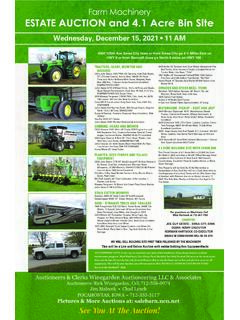Transcription of Quick Square Instruction Manual
1 QuickSquare 0 10 20 30 0 10 20 30 Instruction Manual INTRODUCTIONThis booklet has been prepared for both the professional carpenter and the do-it-yourselfer! The information pertains to general roof construction and specifically to the Stanley Quick Square & Pocket Square tools. The illustrations and instructions contained within this booklet are presented as recommended practice, but by no means do they imply that other techniques are not valid or acceptable. Why not get yourself a cup of coffee, sit down, relax and read through this material to familiarize yourself with the features of the Stanley Squares, and refresh your memory of the various terms and definitions used in roof construction.
2 We start by illustrating the most common shapes of roofs, roof terminology, definitions, and types of rafters. Following is a description of the Quick Square and Pocket Square , and how they are used for rafter layout with illustrations and illustrated examples. Then we describe and illustrate the additional features and uses designed into the Stanley Squares, such as the pro-tractor scale, the inch scale, and how to use the Square as a saw guide. At the rear of the booklet are tables of actual rafter lengths of common, hip and valley rafters for various building widths and roof rises, as well as a table for determining the differences in length of jack rafters for various on-center sit back, relax, and let us show you how "Stanley helps you do things right" 3 TYPE OF ROOFST here are numerous types and shapes of roofs.
3 The most common in use are the following:Shed or Lean-To-Roof This is the simplest type of roof and has only a single slopeGable or Pitch Roof This is also a simple roof and the one most commonly used. It has two slopes meeting at the center or ridge and forming a Hoof This roof consists of four sides, all sloping toward the center of the building. The corner rafters run up diagonally to meet the and Valley or Hip and Valley This is a combination of two gable or two hip roofs intersecting each other The valley is the intersection of the two slopes al the roofs, which run in different directions There are numerous modifications of this type of roof, and the most common is where the intersecting roofs are at right angles to each Roof This type of roof occurs when the rafters rise to meet a flat surface or "deck" instead of corning together at the OFLEAN-TO ROOFGABLE ROOFHIP ROOFGABLE & VALLEY ROOFHIP & VALLEY ROOFDECK ROOF4 Definitions.
4 There are many numbers of publications available concerning framing, roof construction and so on. For the most part these publica-tions are fairly consistent in the terminology used in describing various structural members, etc. Unfortunately, when it comes to using certain terms relating to such things as rafter cuts, different words are used to mean the same thing-even within the same publication ( bottom cut, seat cut, heel cut, fascia cut, etc.). Therefore, in the interest of consistency and clarity, we shall use one term in these instances. The following definitions relating to the various roof members and terms used in roof construction-and throughout this booklet-should be carefully noted and committed to The sloping structural members which support the roof.
5 There are four distinct types of rafters, Common, Hip, Valley and Jack.(Ref. Booklet Cover).Common Rafter A rafter extending from the plate to the ridge or ridge board and perpendicular to the plate and ridge in a plan Rafter A rafter extending diagonally from the outside corner of intersect-ing plates to the ridge board, usually at an angle of 45 to the plate in a plan view,Valley Rafter A rafter extending diagonally from the inside corner of intersecting plates to the ridge of one of the intersecting roots. In most cases at an angle of 45 to the plate(s) in plan Rafter A rafter that does not extend from plate to ridge. They lie in the same plane as common rafters and either abuts plate and hip, ridge and valley or hip and valley rafters, and is classified as follows:Hip Jack A rafter extending from plate to hip rafter at right angles to the plate in plan Jack A rafter extending from ridge to valley rafter at right angles to the ridge in plan Jack A rafter extending between a hip rafter and a valley rafter at right angles to the ridge and plate in plan view.
6 A cripple jack abuts neither a ridge or : (Continued) CutsNaturally all rafters must be cut to specific dimensions in order to properly fit in the space they are to occupy. The mating surfaces of the rafter and abutted roof members must fit flush, and as witnessed by the variety of roof styles and different kinds of rafters. A variety of cuts will be required to insure a proper rafter fit. There are basically four cuts made on rafters plumb, seat, heel and side Cut The cut at the top or bottom of any rafter, which is perpendicular to the span (width) of the building when the rafter is in position. (Also called the top plumb or bottom plumb cut.)
7 Seat or Level Cut The cut made at the bottom of any rafter resting on the horizontal surface of the Cut The cut made at the bottom end of any rafter, which bears against the vertical surface of the plate. Note that this is parallel to the plumb Cut The cut made at the end of a rafter that abuts the ridge or other rafter at other than 90 in plan view. This cut is required at the top end of all hip, valley, and hip jack and cripple jack rafters and at the bottom end of valley jack and cripple jack rafters. (Also called cheek or bevel cut.)PLUMB CUTSEAT CUTPLATEHEEL CUTPLUMB CUTPLATESIDE CUTPLUMB CUTRIDGE BOARD6 Definitions: (Continued)Cuts (Continued)Birds Mouth The notch formed, at the bottom end of rafters, as a result of a seal cut and heel cut is called a birds mouth.
8 The depth of birds mouth is made to the location of measuring line. (Refer to definition of measuring hoe")Ridge Board The ridge board is the horizontal member at the peak of the roof to which the upper ends of the rafters on both sides of the roof are fastened. In less expensive construction, sometimes the ridge boards are omitted and opposite rafters are fastened to each other forming the The plate is the roof member to which the lower ends of the rafters are fastened. The plates are located on the tops of the outside The span of a roof is the distance from outside of the building wall to the outside of the opposite wall, or basically the outside width of the The run of a roof is the horizontal distance from the center of the ridge to the outside of the wall (or plate).
9 In equally pitched roofs and where the plates are on the same plane, the run is equal to half the span, therefore, half the building width. In shed or lean-to type roofs, the run is equal to the span, less the thickness of the CUTBIRDSMOUTHHEEL CUTRIDGEBOARDRAFTERSPLATESPANRUNSPAN2=RU N7 Definitions: (Continued) Rise The rise of a roof is the vertical distance Rom the top of the plate to the intersection of the measuring tines of opposing common rafters. (See "Measuring Line" for the location of this line on common rafters.)Unit Rise The unit rise of a roof is the vertical distance a roof raises for each 1 foot of roof run (unit run).
10 Pitch The pitch of a tool is the ratio of rise in feet to span in feet Or unit rise to unit span. To find the pitch, divide the rise by the spanSlope The slant of a roof is more commonly being expressed in terms of "slope" as opposed to "pitch." Building plans usually include the roof slope defined by a small triangle, called the slope Triangle. The slope of a roof is the ratio of the rise in inches to a run of 12 RISE1 FOOT(UNIT RUN)RISERISESPANSPANPITCH#RISERISERUNRUN SLOPETRIANGLERISERUNSLOPE#8 Definitions: (Continued)Eave Most buildings are constructed with an overhang, that is, the roof ends beyond the outside wall of the building.















